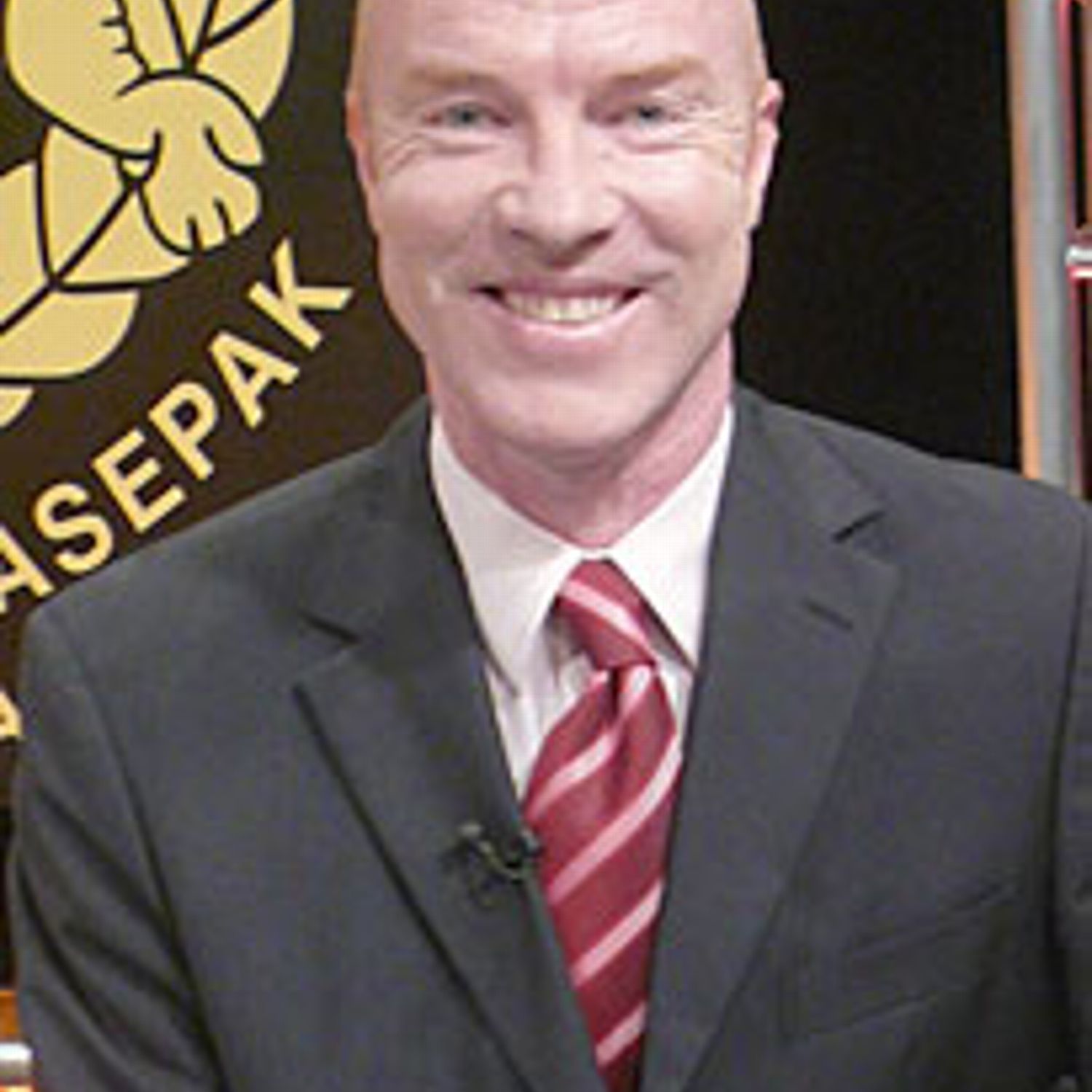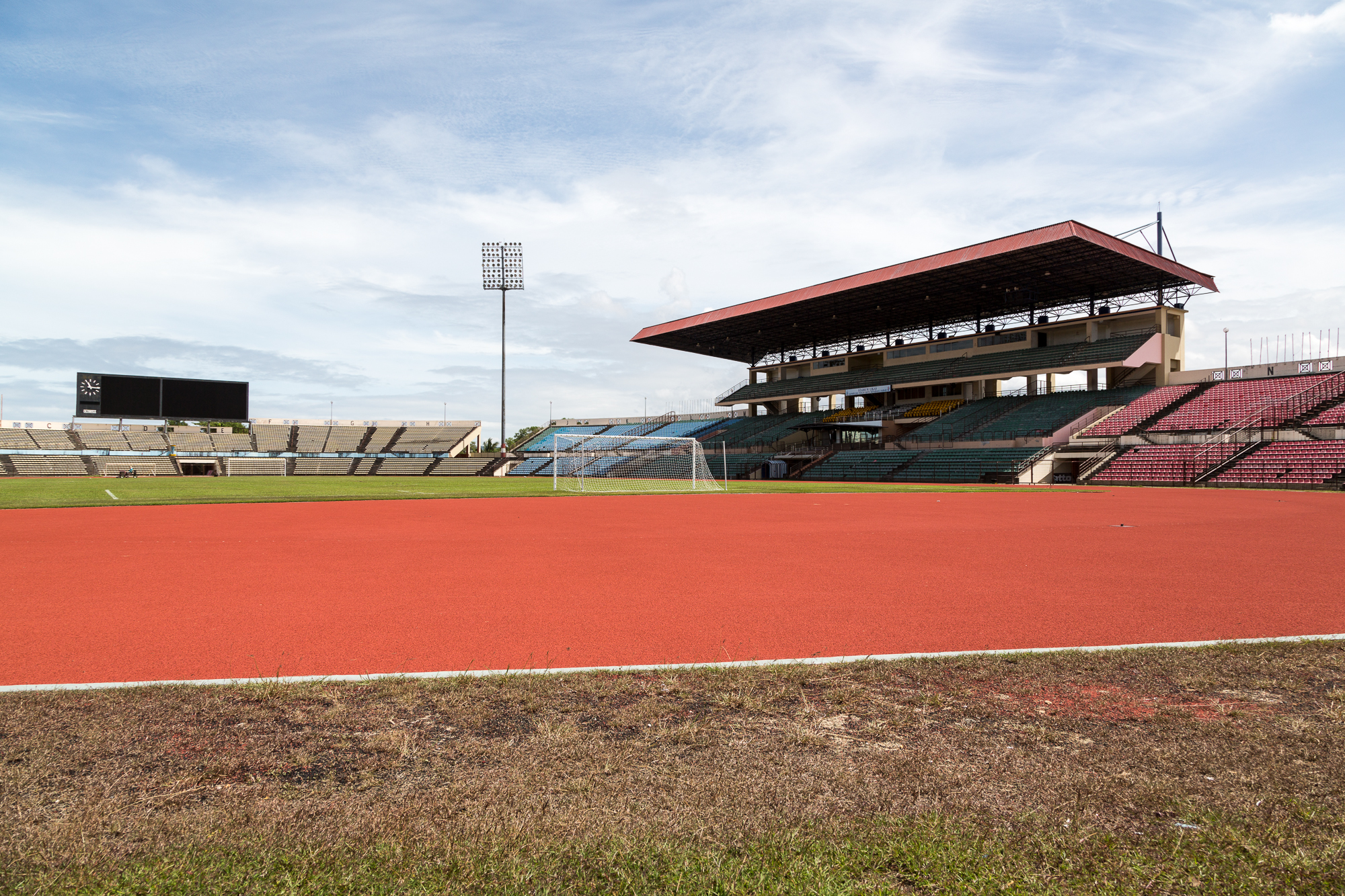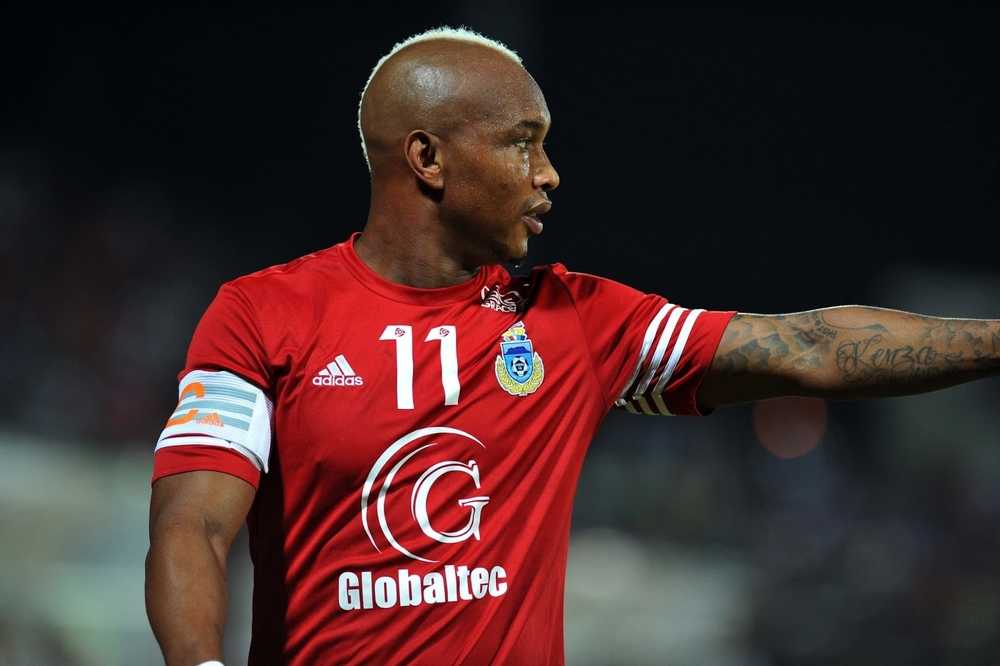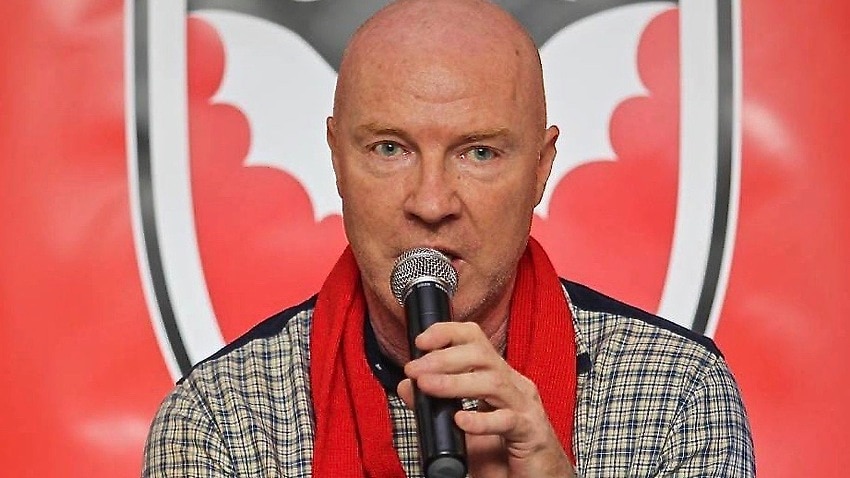Saving Sabah FA, the sleeping giant of M’sian Football
Given what has been happening in the “Land Below The Wind” during the off-season, I feel compelled to now broach this subject.
Yes I admit it, I love Sabah and I am proud to have lived in Kota Kinabalu with my wife and 2 kids for the past 20 years.When I was first approached to write a bi-weekly article about topics involving Malaysian football for this website, I promised myself that anything about Sabah football was taboo.
CHEERS…. Nilakrisna James with Borneo Cup Tournament Director, Scott Ollerenshaw.
Sabah has changed a lot over the past 20 years. For example, Kota Kinabalu has been afforded city status and yes, the traffic is at times frustrating but we still have our beautiful islands within 10 minutes from the mainland, our famous Mount Kinabalu and not forgetting our amazing resorts & golf courses.
From my perspective, all that is needed to make Sabah perfect in every way is a football team that can make the Sabahans proud. A team that is competing in the Super League, mixing it with the JDT’s, Kelantan’s & Selangor’s of Malaysian Football and playing in front of full houses with the famous Likas Roar coming back to Likas Stadium.
The fact that fans still constantly talk about the teams of 94, 95, 96, 97 and 98 on social media is an indication that success has been minimal for Sabah football in recent times. As good as those times were, it’s now time for the fans to have a team that they can be proud of right here, right now; not having to talk about the past to make them feel good about their beloved Sabah Rhinos.
Coaches; both local & foreign have come & gone over the years. They arrived in Kota Kinabalu with big plans & big statements of how they were going to transform the team and bring big success. Sadly, most left fewer than 12 months later, with deeper pockets but zero achievements. And then, another coach would arrive and then another. An exception to this and to be fair, both Peter Butler & Gary Philips did have fleeting success in Sabah though both were removed from their post for whatever reason, before they had a chance to build on it.

And suddenly, late in 2014, we had the arrival of George O’Callaghan. Again, we heard the same old statements promising success. However, there were many red flags from the outset. He was 35 years-old, had a journeyman career at best in the UK, no coaching licence & never coached or managed before. He had little knowledge of Malaysian football, local players and had a dodgy past with DUI in the UK. It was hard to see just what positives George brought to the job.
Having said that, George O’Callaghan is now history, based on the reports we’ve seen over the past few days. What’s important is the next appointment. Datuk TC Goh re-associating himself with Sabah Football is a massive plus point and let’s hope his involvement is for the long haul so he can help bring some long-term planning & common sense to football in Sabah. If anything, the last 15 years has proved that success will not come from short-term planning. Sabah FA need to appoint a coach who can implement a medium & long-term plan that is sustainable and promotes longevity. Once this coach is appointed, they need to support him no matter what and stick to the medium & long-term plan. I’m sorry but hiring a new coach every year and recruiting rejected players will not going to result in a successful football club.
From my perspective this plan will include,
1) Realistic performance-related goals for senior team in 2015
2) Performance-related goals for senior team (2016 & 2017)
3) Recruitment of both Sabahans who are not in the team and quality West Malaysian players who can improve the team from 2016 onwards. These players must be identified by mid-2015.
4) Training Facilities, injury treatment & prevention, dietary requirements must all be improved massively.
5) Youth Development Programs; for example, Junior Leagues to be set up all over the state in order to produce state players for the future.
6) Marketing & PR plan; Improving the team’s relationship with the fans, including school visits by players.
This is just the tip of the iceberg but it is imperative that a sustainable long-term system is put in place by a coach who Sabah FA trusts for a minimum 5 year period. No matter what happens in 2015, the coach & his staff must be given the time to implement his methodology and see the project through to the end. Football is no different to the business world, you can’t just run a club year by year with no detailed planning and expect success. A successful youth development program and a strategic recruitment policy is amazingly neglected by many Malaysian teams.
Alex Ferguson was backed by Manchester United during difficult times and look at his amazing record. More recently, Socceroos’ coach Ange Postepogolou took time to implement his philosophies but suddenly, the Socceroos are playing a style of football not seen for a long time at the ongoing Asian Cup.
Once Sabah FA appoint the next coach, they need to back him no matter what and give him the time to bring the success that the fans are craving for. Datuk TC Goh is a successful businessman. Lets hope his next coaching appointment is just as successful and that the sleeping giant of Malaysian Football is revived.
Socceroos Greats - Where are they now: Scott Ollerenshaw
Winger Scott Ollerenshaw, who was in the Australian team that destroyed world champions Argentina in the 1988 Bicentenary Gold Cup, revealed that he played most of his football off the cuff because he knew very little about the concept of the game.
Former Socceroos captain Paul Wade, who opened the scoring in that epic match against Argentina, rates Ollerenshaw as a winger "who had the ability to take on defenders and beat them" and as someone he "would have hated to face as a fullback".
And Ollerenshaw did it his way ... without even comprehending the finer aspects of the game such as roles and tactics.
"As a junior I loved taking on defenders because I had a bit of speed and I did not have any fear," Ollerenshaw said.
"When I look back I realise I did not really understand how to play football, even when I was a full international. I did not get the concept of the game. I played off the cuff and freely took risks.
"Frank Arok always told me to back myself but I only started understanding the game's roles and tactics after I turned 25, well after my Socceroos days, which is when Ron Smith came over to Malaysia to coach my team Sabah in the mid-1990s.
"He made me aware of things I had no idea about and it was then that I started looking at football in a different way and everything started to make sense."
Ollerenshaw, who is now 51, spoke about his club and international career that was cut short in his prime by serious injuries. What are you doing now?
"I live in Sabah in the Malaysian part of Borneo. I am still involved in football but I do not have the pressure to win games any more. I bring foreigners into south-east Asia and help those with mixed heritage such as Aussies Brendan Gan and Matthew Davies to play professionally in Malaysia. I also do a lot of junior and amateur football tours."
St George were your first club. What made you join the Saints?
"The Saints were my local club. I started playing for Forest Rangers in the St George Association and ending up with St George was a natural progression for me. I started training with the first team and just basically waited for my chance."
You made your first grade debut at 18 and played for the Socceroos at 19, which was remarkable considering you did not 'understand' the game. You were not exactly a late bloomer, were you?
"I was in the Australian team that qualified for the 1987 World Youth Cup but Les Scheinflug dropped me for the finals. Six months later I was in Arok's Socceroos team which goes to show that football is all about opinions. Frank obviously saw something in me that Les didn't but I hold no grudges. I have nothing against Les and whenever I see him we greet each other warmly and I still call him 'boss'."
What are your best recollections of playing for St George, Sydney Olympic, APIA Leichhardt, Wollongong City and Northern Spirit in the National Soccer League?
"Every single game was hard. There were some unbelievable guys playing in my days. The NSL was a cocktail of highly technical players and hard core old style pros. Guys like Peter Katholos, Oscar Crino and Zarko Odzakov could have played in many leagues abroad. Then you had the tough defenders like David Ratcliffe, for example. The standard was high, especially when you remember that we were semi-professional players who woke up at seven, went to work and were at training at five."
In 1992 you signed for English fourth division side Walsall. What was it like playing in the West Midlands in the shadow of such a big club as Aston Villa?
"Funny you should say that because an old teammate of mine at Walsall and one of my best friends is Dean Smith, who is Villa's current manager. We are still in contact and give each other banter over the Ashes. From the playing side I admit it was the hardest year of my life. Those days teams in the lower divisions did not play out from the back and every goal kick was a punt to the halfway line. As a relatively small-ish striker playing in a league like that you were basically feeding off scraps. But a year at Walsall made me a mentally tougher footballer."
You are best remembered for your strong performances for Australia in the four-team Bicentenary Gold Cup in 1988. Tell us about that amazing 4-1 win over Argentina in Sydney.
"I was the youngest player in the team. We had had a very tough pre-season under Frank - doing crazy, crazy stuff - and we were incredibly fit when we faced the Argentines. Australia had faced Brazil in the first game and main striker John Kosmina got injured and everybody expected Robbie Slater to take his place for the second game against Saudi Arabia. But I got the nod and scored the first goal in a 3-0 win that set us up for the Argentina clash.
"I recall Frank giving us an unbelievable motivational speech before the game. He told us that we were good enough to take on Argentina and that we had a unique opportunity to gain some respect for Australian football that would give more opportunities for the next generation of Socceroos. It was 'hairs at the back of your neck' stuff and the whole team responded.
"I also remember walking down the tunnel from the dressing-room and looking sideways at the Argentine team as a 19-year-old kid and I said to myself 'Jesus Christ, look at the size of them'. They were absolutely huge. On the pitch I just followed instructions and did a few good things and the rest is history."
"We went out there with no fear and everything clicked. It was just a fantastic night."
How did the Argentines take such a humiliating loss that made world headlines?
"Not very well. During the game they were getting frustrated and dished out a few elbows when the ball was at the other end. They were quite upset and nasty but that's Argentina for you when things do not go their way. The Argentines were just embarrassed to be losing to a bunch of minnows.
"We played them on a Thursday night and on the Sunday afternoon we had to play the final against Brazil. But on the Friday morning we were still celebrating the big win and we were coming out of bars at 4am blind drunk. It would not happen today but those days it was old school. We lost the final 2-0."
You also formed part of the 1988 Olympic Games squad. After playing in the qualifiers, did you expect to be used more than once as a substitute in Korea?
"A few days before we travelled to Korea, I had appendicitis and had to have my appendix taken out. It was touch and go if I would go to the Olympics but amazingly three days after surgery I was jogging so I was passed fit. I missed the first two games but came on late against Nigeria. It would be fair to say that without the appendicitis I would have played more."
The late 1980s however must be the most rewarding period of your whole career.
"I think so. My only regret is that it happened for me too early in my career and I did not fully appreciate how lucky I was. I was young and I had no expectations, I just got there out and played. I had a bad period in the early 1990s when I played like shit and it was not until I came to Malaysia that I started playing the way I could."
The 1990 World Cup campaign effectively went off the rails when Australia lost 2-0 away to New Zealand. What do you remember of your last full international match?
"It was a typically physical game against New Zealand. They were highly motivated and did the hard yards and I don't think we played well. That was a killer because had we won or even drawn that game in Auckland we would have needed a draw not a win against Israel in our last game to progress to a playoff with Colombia. We drew 1-1 with Israel and we were out."
Arok helped you become an international player. What were his best attributes?
"I was always scared of him. When I was a young kid coming through I used to watch the first grade games at the old St George Stadium and Arok with his touchline theatrics came across as a pretty scary figure. Once you got to know him, however, you found out his best attributes such as his man management skills. He made you want to play for him and run through a brick wall for him. For me his style of management was one of the reasons he was so successful."
You were not known as a scorer but you made many goals at club and country level. Do you feel that you often did not get the recognition you deserved? Few people talked about assists those days.
"It is not something I think about, to be honest. I had my career and enjoyed it. When your career finishes you just move on. There is nothing worse than a bitter and twisted former footballer."
Did you ever imagine when you started kicking a ball in anger that you would end up playing in Borneo, which is more famous for orangutans than football?
"Never. If you had asked me that back then I would have laughed at you. But in the NSL we all had to work so many Aussies came to Malaysia essentially because over here we earned double what we earned in the NSL The opportunity arose for me and I came here and had a great time."
Injury forced you to retire at 31. What happened there?
"Basically, I signed for Northern Spirit and (player/coach) Graham Arnold was aware I had some injury problems. When I came to Australia I was told I had bone on bone in my hip and ankle, with virtually no cartilage in between. Back in those days we thought we would keep fit by going on the hard road and do five-kilometre runs. That was probably the worst thing I could do, I had surgery on my ankle and a few games in the State League but I just knew it was all over for me and I retired."
Was that the biggest disappointment of your career?
"Not really. I'm pretty phlegmatic about that. I tried to keep going but I had to accept it."
Finally, who were the best players you have played with and against?
"When I was with the Socceroos, defender Alan Davidson took me under his wing and taught me about mental toughness and how to handle myself. He was very experienced and everything he did was simple and about getting a result. Playmaker Crino was a fantastic player with great skills.
"The best opponents would have to be Brazil's Romario, whom I faced in the '88 Gold Cup. I also played against David Beckham, Paul Scholes and other Manchester United stars when they played a Selangor selection in Kuala Lumpur in 1995. We lost 4-1 but I scored the 'Malaysian' goal."
SCOTT OLLERENSHAW FACTFILE
Club career
1986-1989: St George
1989-1991: Sydney Olympic
1991-1992: APIA Leichhardt
1992-1993: Walsall
1993: APIA Leichhardt
1993-1994: Wollongong City
1994-1997: Sabah
1998: Negeri Sembilan
1998-1999: Northern Spirit
International career
1987-1989: Australia (14 matches)
Please Share This article:





.jpg)





Post a Comment
0Comments